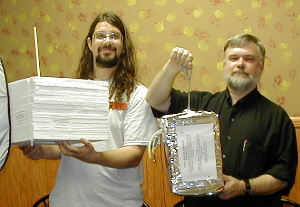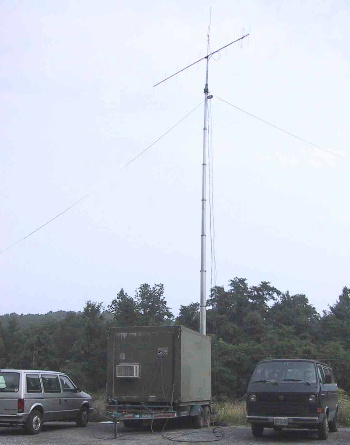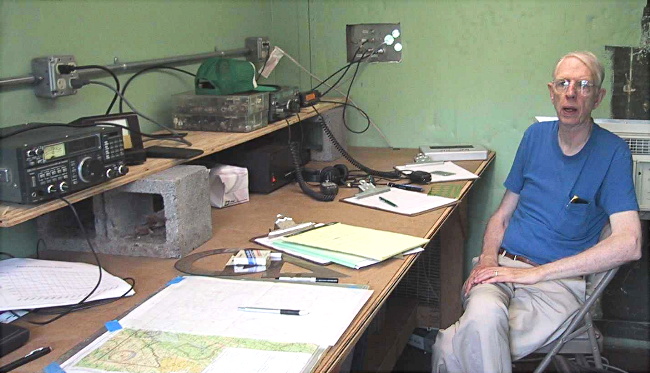Mission Control For Sky-Eye II - Flight
2002A
Reported By John Unger, W4AU
July 22, 2002
I'm writing this in my hotel room in San Diego just 48 hours after our successful
balloon launch, and I still can't keep myself from smiling when I think about
how well all phases of the operation went. The entire team should be immensely
proud of a job well done! Unfortunately, I have left all of my balloon-related
notes and files back home, so I can't add times and other pertinent information
this report and have to rely on my marginal memory...
Our Fight 2002A Payloads

John Rehwinkel - KG4L
with Sky-Eye II
and Tom Dawson - WB3AKD with Flight Instrumentation
Mission Control's efforts started on Friday afternoon with Tom Dawson - WB3AKD
delivering the communications shelter to Snickers Gap. I'm not sure that
all LARGERs realize what a tremendous resource this shelter is for the club.
We are very fortunate to have it available for events like Field Day and
for balloon launches. The telescoping mast adds greatly to the utility of
the shelter. At any rate, with Charlie Preston - K4LJH and I giving appropriate
hand signals, the shelter, on its trailer, was soon parked at the high point
on Snickers Gap at the junction of Rt 7 and Rt 601. After a quick check-out
on the compressed air and electrical systems and the antennas, Tom handed
over the keys and took off to finalize his launch preparations.
Charlie and I arrived at the shelter about
0650 Saturday morning after chatting on the way from Hamilton with some of
the trackers headed off to their sites. We rigged the antennas and coax per
Tom's advice. We set up three antennas: an 11-element 2-meter Yagi, a 2-meter
J-pole, and a 40-meter dipole. The J-pole was used for communications and
sat on the very top of the mast; the Yagi was about 6 feet below the J-pole;
and the tape dipole was set up as an inverted V with its center at the Yagi's
rotator right at the top of the 50-foot telescoping mast. All of this rigging
of antennas and feed lines took time because we wanted to get it right the
first time, without everything getting all tangled. We also checked out all
three antennas with my analyzer; they were right on the button!

WB3AKD shelter set up and ready to go at Snicker's Gap
as Mission Control with 2-meter Yagi and 40-meter inverted V antennas.
W4AU generator set up out of sight to
keep noise levels down to a minimum.
Jacob Dawson, KF4VLQ, showed up about 0745 with the radio gear and some other
essentials. Shortly after his arrival, we hooked up the compressed air tanks
and raised up the mast without a hitch. At that point we began installing
radios and organizing the inside of the shelter for our operations. After
the 2-meter comms radio was hooked up, we powered up the generator just to
make sure everything was working OK and established communications with some
of the tracking teams. It became obvious that we were not going to have any
luck with 40 meters as a comm frequency with the launch team; I haven't looked
at the sun spot activity, but there had been a forecast of some bad flares
over the weekend. Fortunately, 2-meter simplex proved to be perfectly fine
for about 90% of our communications needs. Having Denny and Carol on North
Mountain for relays helped a tremendous amount. Multi-pathing and/or abnormal
solar activity did cause a lot of distortion on 2-meters, though.
After the launch team gave the "ready to launch", we queried the tracking
teams to make sure that they were in position and then gave the launch team
the go-ahead to release the balloon at 0931. Sky-Eye-II was launched shortly
thereafter. We acquired the signal loud and clear almost immediately and
began recording the telemetry signal on the computer as it rapidly ascended.
We began getting tracking bearings from the teams right after they all had
acquired the telemetry signal. The bearings were quite reliable and generally
converged on the balloon position as it first began to rise.

Charlie Preston, K4LJH of
Hamilton, manning the VHF link
from Mission Control to the tracking teams and the launch team from inside the WB3AKD communications shelter
We soon got into a routine with Charlie on the comms querying the tracking teams, John plotting the fixes from the bearings and relaying the approximate fixes back to the teams in the field, and Jacob manning the computer and tracking the various balloon telemetry signal outputs.
As the balloon got to about 50,000 feet, the fixes seemed to less well defined
even though the signal strength was excellent. We clearly monitored the balloon
bursting between frames 88 and 89
(see
Tom's report) and watched it begin its descent. The bearing started to
converge better as the balloon came back to earth, and out final fixes seem
very reasonable in hindsight given the final resting place of the balloon.
Mission Control was very cautious in the beginnings of the recovery phase of the launch given the wide area of strong signals from the downed telemetry package. We did not want to rush everyone into the northeast end of North Mountain right away even though that seemed to be the place with the strongest signal. We had gotten some very strong signal reports from a ham near Strassburg and dispatched trackers to that area and had them follow the signal to the north, just to be on the safe side. As we all know now, the balloon landed within a mile or so of Denny and Carol Boehler's tracking location on North Mountain, and thanks to their careful preliminary bearings, we were able to vector the rest of the recovery teams to that location.
When it became obvious that Mission Control's location was less than optimal to coordinate the rest of the recovery phase, we passed the Mission Control duties over to WB3AKD, who coordinated the final recovery, and we all know the happy ending to the story from that point.
As we listened to the final phases of the recovery on the mobile rigs, we
took about 45 minutes or so to take down antennas, pack things up, and clean
up the shelter.
Best Regards, John Unger - W4AU de Hamilton, Virginia
NNNN